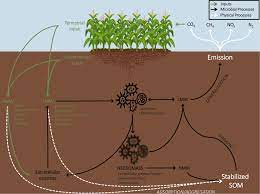
The global imperative to address climate change and promote sustainable agriculture has underscored the critical role of soil management practices in enhancing carbon sequestration and reducing greenhouse gas emissions. This research focuses on quantifying the carbon sequestration potential of diverse soil management techniques aimed at increasing organic content in soil while minimizing the use of chemical inputs. It integrates a multidisciplinary approach, conducting field experiments across diverse agroecological regions with different soil types and cropping systems. Key practices under investigation include cover cropping, crop rotations, conservation tillage, compost application, organic amendments, integrated pest management (IPM), and precision agriculture. The study assesses their impact on soil organic carbon levels, greenhouse gas emissions, soil health indicators, and crop productivity through comprehensive data collection and analysis techniques. Statistical analyses and modeling are employed to quantify carbon sequestration rates, evaluate treatment effects, and assess environmental and agronomic benefits. These practices are implemented in controlled trials to assess their impact on soil organic carbon (SOC) levels, greenhouse gas emissions (CO2, CH4, N2O), soil health indicators (microbial biomass, nutrient cycling, soil structure), and crop productivity. Data collection and analysis techniques involve comprehensive soil sampling, greenhouse gas flux measurements, soil health assessments, and crop yield monitoring over multiple growing seasons. Statistical analyses and modeling approaches are employed to quantify the carbon sequestration rates, assess treatment effects on soil health and greenhouse gas emissions, and evaluate the overall environmental and agronomic benefits of the soil management practices. The study aims to contribute valuable insights into evidence-based strategies for promoting sustainable soil management practices that enhance carbon sequestration while maintaining or improving agricultural productivity. The findings will have implications for informing agricultural policies, guiding farm management decisions, and advancing research on climate-smart agriculture. By quantifying the carbon sequestration potential of different soil management practices, this research contributes to the broader goal of achieving climate resilience, environmental sustainability, and food security in agricultural systems.
Total file downloads: 64